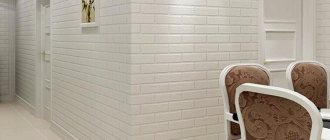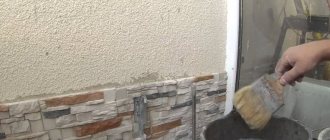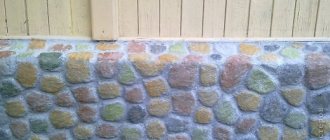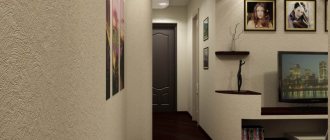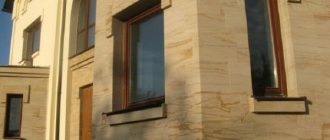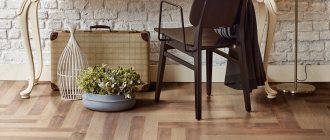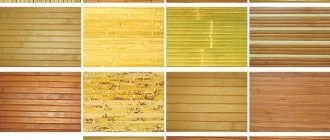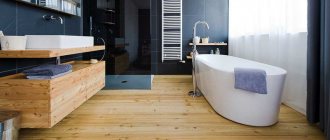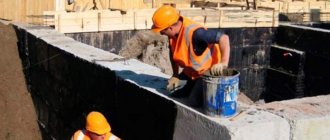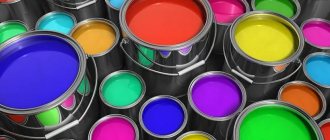According to the majority of modern designers, of all the new materials, flexible stone is the most successful attempt to accurately transfer the texture of a natural material onto an artificial base. The starting material for its production is sedimentary rock, which is a monolith of clastic grains (up to 2 mm in diameter), called “sandstone”.
RysikMur participant FORUMHOUSE, Moscow.
Flexible stone is not plastic. This is the thinnest section of natural sandstone, applied to a flexible base - fiberglass.
Flexible stone is produced both in the form of wallpaper (rolls from 2 to 2.8 meters) and in the form of tiles (50×600, 200×300, 600×300, 800×400 mm), which, when used skillfully, demonstrates enviable aesthetic results.
Like any other building material, flexible stone has its advantages and disadvantages. And, given that he has more of the former than the latter, first of all we will list his advantages.
What is flexible stone and how is it made?
This is a new finishing material patented in Germany. This is a kind of three-layer cake, it consists of fiberglass, an adhesive mixture and the smallest particles of mountain sedimentary rocks - sandstone or marble chips. It is made using two technologies: manually (note to entrepreneurs) and in production. To make it yourself, you will need:
- The table is large and stable.
- Pallets with sides.
- Thick glass on which the slabs will be formed.
- Rack for drying finished products.
- Well ventilated area.
Marble or sand chips are sifted to remove large particles and, if necessary, painted with a special composition. The base - fiberglass - is placed on a pallet, covered with an adhesive composition and stone-sand chips are poured. Then they press down on top and leave to dry for at least a day. When it dries, all that remains is to shake off the stuck crumbs. This is a good and almost unoccupied niche for small and medium-sized businesses.
As for industrial production, it makes sense to develop it where there are sandstone deposits. A thin layer with a unique pattern is cut, sanded and glued to the base. Dry under pressure and remove from the base. The process turns out to be more expensive and labor-intensive due to the high cost of equipment, but the product is more durable.
Properties of flexible stone
So, flexible stone is a new generation finishing material. Its advantages:
- Does not burn, does not allow water to pass through.
- It is environmentally friendly and contains no toxic substances. The decorative layer is of natural origin, and the bonding composition is absolutely harmless.
- Durable, can last for decades. Designers guarantee trouble-free operation for 35 years.
- Easy to install and use, leaving no waste.
- Not subject to temperature changes.
- It is universal - it is used for both interior and exterior decoration.
- It is very flexible, and this is its main advantage. Allows you to cover any surface without any problems.
- And, of course, it is not afraid of microorganisms and high humidity.
- Frost-resistant.
- It is lightweight and does not create a load on any building structures.
- In operation, it can withstand temperatures from -45 to +65 degrees.
- Can be mounted on any surface.
- Lastly, he is simply beautiful. Its unique appearance gives great scope for designers.
You can cut it using a regular construction knife or scissors. Well, are there any disadvantages? So far, only one serious drawback has been identified: the high price.
Advantages and disadvantages
Before moving on to considering the advantages and disadvantages of flexible stone, it is necessary to present the characteristics of the material, some of which are positive properties:
- the weight of one square meter does not exceed four kilograms;
- operating temperature range is from -45 to +700 degrees Celsius;
- withstands up to 100 freeze/thaw cycles;
- low flammability, class G1 in accordance with GOST 3044-94;
- the texture corresponds to natural decorative stone.
Flexible stone Classic 1 in a roll. Photo by SENATE-TECHNOGROUP
The main advantages are:
High flexibility and elasticity. The structure of the material resembles ordinary wallpaper, which greatly facilitates installation and allows you to implement almost any idea. The ability of the material to follow various surface curves ensures its use for cladding objects of any shape. To cover structures with sharp corners, it is possible to use a heat gun, which will help the wallpaper take the required shape. Thus, the material also has versatility and functionality.
Environmental friendliness. The flexible stone contains only environmentally friendly and safe components; there are no toxic impurities, radioactive additives, or decomposing compounds. This allows you to use stone for cladding surfaces in any room.
Fire resistance. The material retains its own properties at high temperatures. Technical characteristics ensure low flammability of the stone. It is fire resistant, does not ignite when exposed to high temperatures and does not support combustion. Therefore, flexible products are used for cladding fireplaces, baths, saunas, kitchens and individual elements of these premises.
Ease. The thinnest layer of stone does not weigh down the cladding. As a result, it is possible to decorate thin and fragile interior and exterior parts with stone. In terms of the weight of one square meter, flexible stone has no equal.
Flexible stone Monochrome-5 in the fireplace lining. Photo PC Flexible Stone
Durability. High wear resistance ensures long service life. Manufacturers and specialists claim a 35-year warranty period.
Frost resistance and resistance to sudden temperature changes , which allows the stone to be used for cladding the facades of buildings located in the northern regions.
Light transmission allows the stone to be used to decorate lamps, which helps create a cozy and calm atmosphere. Or you can make interesting lampshades for lighting fixtures from flexible stone.
Air permeability allows the stone to maintain natural ventilation and prevent the formation of condensation, and, accordingly, ensures optimal indoor conditions.
Lack of reaction to moisture and regular contact with water , water resistance, which allows the material to be used for finishing problem areas: bathrooms, saunas, swimming pools.
Flexible stone, Golden Autumn marble in the form of tiles. Photo by SENATE-TECHNOGROUP
Easy to install. Cladding with flexible stone does not require any special knowledge or skills; anyone who has ever hung wallpaper can handle the job. The products are easily cut with scissors or a knife.
The ability to obtain a seamless coating by achieving the creation of a monolithic coating.
A variety of shapes, textures and colors , which allows you to choose products for the design of any room, select products of the optimal size and avoid unnecessary cutting.
Easy to maintain , does not require special measures, just periodically wipe the coating with a damp cloth. The rough surface promotes the accumulation of dust, which can be easily removed with a regular vacuum cleaner.
Cladding with flexible stone brings sophistication and elegance to the interior and façade of buildings. If we add to this vapor permeability and antistatic properties, it becomes clear why the material is so in demand.
However, the stone also has disadvantages. The main disadvantage is the high cost . To obtain a cladding that meets all of the listed properties, you must choose high-quality products from a trusted manufacturer . The price also depends on the production technology. One way or another, the cost of flexible stone is close to the prices at which natural rock is sold. That is why many potential buyers are interested in self-production technology.
Another disadvantage is the high requirements for the quality of the base . The surface intended for cladding must be flat. Base defects increase installation time and work costs.
A large number of counterfeits increases the likelihood of purchasing products that do not meet the declared characteristics. For its manufacture, binding elements are used, which make the finished products difficult to bend and provide them with a rough surface. As a result, the products do not adhere well to the base, and over time there is a high probability of cracks forming.
Types of flexible stone
- Stone wallpaper. Just like regular wallpaper, it is produced in rolls, just like regular wallpaper, it is used mainly for interior wall decoration. And they glue them in exactly the same way, with the only difference being that the sheets must be glued closely, avoiding overlaps. Layer thickness is 1-1.5 millimeters.
- Stone tiles. It is thicker than wallpaper - about 2-5 millimeters. Used to cover floors and house facades. The size of the tile and its color leave room for the imagination of customers and designers.
- Sheet flexible stone - has the same thickness as tiles, but is produced in plates. The dimensions of the sheets vary widely, but the maximum size is 250 centimeters.
- They are based on polystyrene foam. If you cover the facade with thermal panels, the energy efficiency of the house will increase.
Well, now let's see where and how this amazing material is used.
Decorative tiles, brick-like and other types
There are three main types:
1) Wallpaper or rolls , some suppliers call this type “sheets”. It is the most popular option. They are produced in the form of a canvas with a thickness (on average) of 1 mm, which is sold rolled up, i.e. in rolls of various sizes. But there are also standard dimensions - 1200x2600 mm. Wallpaper is the optimal solution for wall cladding ; it is most often used for interior decoration. The rolls easily lie on a smooth surface, on objects of convex and concave shapes, and follow the curves of the base, emphasizing the relief. Installation is carried out using almost the same technology as conventional wallpaper, i.e. the canvases are fixed to the surface using an adhesive composition . Manufacturers offer a large number of interesting solutions : flexible stone to look like bricks, applying frescoes to canvases, etc. Some enterprises offer favorable conditions for purchase.
Attention. Installation is carried out WITHOUT overlapping one sheet onto another. The volumetric texture will only highlight finishing errors.
2) Tiles. The main difference from the first type is the thickness, which is 2.5 mm. Tiles are available in a wide variety of sizes. The minimum standard is 80x265 mm, the maximum is 340x550 mm. This allows you to use tiles both for wall cladding and for decorating individual areas: arched vaults, steps, fireplaces, etc. Manufacturers meet customers halfway and produce products in individual sizes . Color solutions are limited only by the imagination of businesses and consumers. Natural-looking tiles that imitate natural noble materials are available for sale.
3) Thermal panels. All types of stone cladding have increased heat resistance, but for finishing stoves, saunas, fireplaces, chimneys and other surfaces that heat up to significant temperatures, it is recommended to use thermal panels. They can easily withstand temperatures up to 700 degrees. They are also used for cladding facades, balconies and loggias, walls and other surfaces. Extruded polystyrene foam or façade foam is used as a base.
Scope of application of flexible stone
Flexible stone is used for:
- Cladding of facades, ground floors.
- Wall decoration in offices and residential premises.
- Decoration of the fireplace area.
- Finishing the work area in the kitchen (kitchen apron).
- Wall decoration in swimming pools, bathrooms, toilets.
- Decoration of stairs and fences in gardens.
- For small decor (lampshades for lamps, for example).
As you can see, the scope of application of this material is very wide, and its demand is also high.
Features of using flexible stone
Let's talk about the application features using the example of stone wallpaper. As already mentioned, they can be used for interior wall decoration, and it will be a very beautiful and durable coating. However, to really make you happy for a long time, strictly follow the instructions.
- Before finishing the walls, you need to prepare them - treat them with antifungal impregnation.
- The glue must be selected in accordance with the polymer that was used to create the wallpaper.
- The glue is applied only to the wall, the back side of the wallpaper remains dry, and it is better to wipe it with a dry cloth before installation.
- Stone wallpaper is heated with a hair dryer so that it adheres better to the surface.
- They must be glued “at the joint”; when pasted “overlapping”, thick wallpaper will immediately reveal errors in the finishing. However, in this case, the seams can be softened by heating them with a hairdryer and then rolling them with a roller.
- Press the wallpaper against the wall with a roller so that it sticks better.
- Remove the protective film from the material with which it is sold. Yes, this needs to be done after installation is complete.
The joints between the wallpaper, if they are noticeable, can be covered with paint to match, or rubbed with wallpaper scraps. You will be able to see what you have achieved only upon completion.
Production of material
The base is textiles and polymers, which are covered with sandstone. At the first stage of production, sections are selected and prepared that will have a unique ornament. The artificial soft stone is polished at the next stage, and then an acrylic mixture is applied to the base. Fiberglass or textiles are glued onto the supporting base, after which the base is removed, and the material itself is sent to the drying stage.
Since the main task of production is the choice of cut, the production of artificial stone requires expensive equipment. Sandstone layers are laid on resin or adhesive. Once the textile is removed, the layer is dried and subjected to processing and then inspection.
Flexible stone for flooring
Stone tiles are an excellent material for flooring. Its advantage is that it is not necessary to pre-level the surface. Lay it down starting from the far corner. After laying the tiles, you need to remove the remaining adhesive and be sure to rub the seams using a special compound and a regular brush. Don't forget to also remove the protective film from the product. “Stone” floors look great in “palace”, art deco and classic styles. Flexible stone can withstand heavy physical load, so it is used where increased strength is required - in the bathroom, in the kitchen.
Installation tools
To carry out the work, you should prepare some materials and tools, namely:
- brush;
- contact glue;
- notched spatula;
- ruler;
- hydrophobic material;
- wooden hammer;
- mounting knife;
- pencil.
The surface must first be prepared. It is most convenient to apply the glue with a notched trowel. If the tile has impressive dimensions, the composition is applied with an even spatula, after which it is necessary to make grooves using a serrated tool.
Laying should begin from the top corner, as it may be necessary to cut off part of the trim, which is recommended to be installed in a less noticeable area of the room.
Flexible stone in the kitchen
There are other uses for this material in the kitchen. What do we expect from a kitchen apron?
- Strength.
- Moisture resistance.
- Insusceptibility to temperature changes.
- So that it does not absorb dirt and odors.
- To be easy to clean.
- To look presentable.
Flexible stone has all these qualities. In addition, it is easy to install and does not deform. A stone apron and stone countertop will give your kitchen an aristocratic look.
Well-known manufacturers and subtleties of product selection
There are many manufacturers of these products on the construction materials market. Many companies are actively trying to use the practice of developing and selling such building materials. The technology for producing flexible stone can be different everywhere. When choosing, it is important to read consumer reviews of products from a particular manufacturer. Due to the fact that nowadays it is quite common to find counterfeits that do not meet quality standards, it is best to purchase products from trusted manufacturers who have managed to earn a positive reputation over a long period of work.
Ceiling decoration with flexible stone
We laid the tiles on the floor, but they can be laid on the ceiling in the same way. This is a truly flexible material, so you can make a ceiling of any configuration. A variety of colors gives room to the imagination and allows you to choose the right tone for any interior style.
Flexible stone in damp areas
The material is not afraid of high humidity, so it is actively used in rooms where this very humidity is in excess: in bathrooms, bathhouses, saunas, swimming pools. The flexibility of the material allows you to paste it over even plumbing fixtures. The color palette does not limit the choice of style.
Decorating arches and columns with flexible stone
It is good to use flexible stone to decorate interior arches. It is beautiful and durable, does not weigh down the interior. In this case, the arch can be of any shape - straight, semicircular, figured - the material, as already mentioned, is very plastic. If you have an arch with columns, then cover them with flexible stone as well.
Advantages and disadvantages
In addition to the fact that flexible stone is absolutely harmless and does not emit any hazardous components during operation, it has a number of other advantages, such as:
- ease of installation;
- low water permeability;
- fireproof composition;
- light weight (no more than three to four kilograms per square meter);
- ease of operation (no special care of the material is required);
- durability (the guaranteed service life can be about thirty-five years);
- preservation of basic qualities at high and low temperatures (the range of product operating temperatures, according to experts, can reach from - 45°C to +650°C);
- the ability, thanks to flexibility, to accept various configurations, which contributes to the implementation of extraordinary design solutions).
If we note the disadvantages, then we can highlight the high cost. Purchasing high-quality material from a trusted manufacturer usually requires costs in excess of 1,300 rubles/m², which is comparable to the cost of natural stone.
External cladding with flexible stone
Everything that has been said above concerns the interior decoration of the room. Now let's see how it can be used outside. Let's start with the stairs. The material is often used to decorate stairs and railings. Most often it is a flexible stone made from marble chips. The staircase looks very rich, the steps are resistant to abrasion.
Finally, the time has come to talk about cladding the facade of the house with flexible stone. There are some nuances here.
- Before starting work, the surface must be carefully prepared: cleaned of dirt, leveled, sanded, and primed if necessary.
- Prepare the adhesive composition according to the instructions.
- Apply a thin layer of it to the surface of the house.
- Press the sheet or tile against the wall and smooth it out well.
- Dry with a hair dryer.
- Apply a topcoat to protect against adverse weather and mechanical damage.
Your home will look very stylish. Want to add even more originality to your look? Combine it with other materials, such as wood.
This material is also used in landscape design - in the decoration of flower beds and gazebo fountains. They can be used to lay out paths in the garden.
Flexible stone decor
Flexible stone is widely used as decoration. This material is translucent, so it is especially good as lampshades or shades for lamps.
The result is very soft diffused light. The absolute non-flammability of the material makes it possible to decorate a fireplace with it. If you place a painting or figurine in a niche covered with stone wallpaper, they will sparkle with completely different colors. Cover the windowsill with flexible stone and your green plants will simply bloom against this background.
The material is used as the basis for a design applied using ultraviolet printing.
Apply it to a wall covered with stone wallpaper and get an image that will not fade for many years. It does not matter where it is located - in the living room or in the bathroom.
Features of using flexible stone
It remains to focus your attention on a few more important points.
- Don’t get too carried away with it: don’t decorate the walls, ceiling, and floor with flexible stone, it will look too intrusive.
- In small rooms, use it carefully, otherwise you can overload the interior.
- The shade of the flexible stone should be in harmony with the color of the furniture in the interior.
- If you lack experience, entrust the interior design to a professional, otherwise the result may disappoint you.
- Do not use flexible stone of the same color. A harmonious interior is achieved if different shades of this material are used.
- If you coat the flexible stone with varnish, its service life will increase.
Of course, the option of finishing with flexible stone cannot be called budget. This position compensates for the long service life. Decorate your interior this way, and you will forget about repairs for decades. We hope that the article has given a comprehensive description of this amazing material.
Scope of use
Flexible stone is most often used to decorate facade walls or interior spaces. By combining natural materials of different types in conjunction with flexible stone, you can achieve an original interior design .
It is especially effective to use flexible coating in damp rooms and in places with high temperatures.
It is also good to design columns, arched elements, decorative balls, stairs, and structures with rounded edges using flexible stone.
Facade work involves special treatment of the flexible coating.
